Andrew O’Connell wrote a blog regarding the link between power and a team’s success. By looking at a computer that simulated a Mount Everest expedition, teams who had overpowering leaders only completed 59% of their goals as opposed to teams who did not have a clear leader completed 76% of their goals. This is interesting because it is common for teams to have one person who dominates group discussion. This widely accepted view is counter productive.
The reason why the group is less efficient is because of an overall lack of different perspectives from group members. When a leader has power they feel the need to talk a lot. This frequency of talking gives others a sense that their opinion is not accepted. In turn, teams do not have different perspectives on tasks.
Businesses can minimize this effect on their team’s performance by training leaders to being more open to ideas, or encouraging subordinates to question a leader’s ideas.







